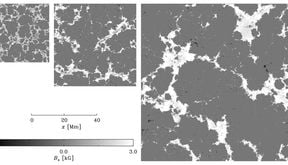Supercomputer can disprove the theory of sunspot formation

The SPOTSIM project, which studies the formation of sunspots, has been awarded competed time on the Mare Nostrum supercomputer in Spain. The awarded resources amount to 20 million CPU hours - a computing time equal to approximately 500 years on a normal laptop. The group of researchers including scientists from Aalto University and the Max Planck Institute for Solar System Research (MPS) in Germany hopes to pinpoint the important role played by turbulent plasma flows within the Sun.
'The simulations are exceptionally large; one data cube in one simulation is approximately 700 gigabytes in size. One simulation produces tens of data cubes, but these cannot all be stored. We would like to have a total of around 15 terabytes of research data in long-term storage,' researcher Petri Käpylä from the Aalto University in Finland and the Leibniz-Institut for Astrophysics in Germany describes the project.
Towards a comprehensive understanding of the larger picture
Modelling the Sun is difficult and there are two competing models for how sunspots are formed. The common assumption has been that magnetic fields are thin tube-like structures at the bottom of the Sun's convection zone in the thin tachocline at a depth of 200,000 kilometres, from where they erupt to the surface and form sunspots. However, this model does not take turbulence into account unlike the model studied in the SPOTSIM project, where sunspots are believed to form near the Sun's surface, in its convection zone.
'Meteorologists say that low pressure in the Earth's atmosphere is filled when air flows into them from the surroundings. Our belief is based on similar turbulent and magnetic pressure in the Sun's convection zone, which is modified due to the large-scale magnetic field. As a result of the negative overall impact of this, plasma can collapse, which causes magnetic fields to grow stronger locally and allows the formation of sunspots to begin,' Käpylä adds.
The new model would influence the Sun's dynamo theory as a whole as well as the understanding we have of the formation and development of the Sun's magnetic field. It would be one step forward in understanding the challenging full picture of the Sun. This picture also includes space weather and climate.
Participants in the SPOTSIM – Spot-forming convection simulations research project include Petri Käpylä (Aalto University and the Leibniz-Institut für Astrophysik Potsdam (AIP)), Maarit Käpylä (Aalto University and the Max-Planck-Institute for Solar System Research), Nishant Singh and Jörn Warnecke (Max-Planck-Institute for Solar System Research) as well as Axel Brandenburg (NORDITA and the University of Colorado Boulder).
Further information:
Petri Käpylä
Research Fellow
Aalto University, Leibniz-Institut für Astrophysik Potsdam (AIP)
[email protected]
Tel. +49 331 7499 525
Maarit Käpylä
Adjunct Professor, Independent Max Planck Research Group Leader
Aalto University, Max-Planck-Institute for Solar System Research
Tel. +49 551 384 979 402
[email protected]
- Published:
- Updated:
Read more news

Get to know us: Associate Professor Maria Sammalkorpi
Sammalkorpi received her doctorate from Helsinki University of Technology 2004. After her defence, she has worked as a researcher at the Universities of Princeton, Yale and Aalto.
Aalto computer scientists in ICML 2024
Computer scientists in ICML 2024
In low-hierarchy organisations, even key policy issues are discussed in Slack
In a recent study, Aalto University alumn Lauri Pietinalho, a visiting scholar at New York University's Stern School of Business, and Frank Martela, an assistant professor at Aalto University, investigated how low-hierarchy organisations deal with shared policies in confrontational situations and how authority functions within them.